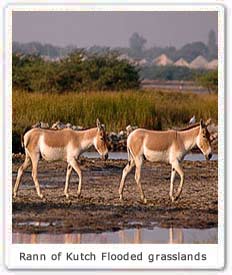Kutch is a seasonal terrain as during the dry season it turns into a large expanse of the salty and isolated mud islands on the vast plains, and with the onset of monsoons these lands turn into the flooded grasslands. The area gets covered with the huge variety of tress and tall grasses. Kutch deserts are the one such deserts which doesn't have sand. It is unique desert which is hot and dry, full of salts and Sat stones.
 Biodiversity
Description :
Biodiversity
Description : Wildlife attractions :
The eco region of Rann of Kutch represents the saline wasteland where scrub flora and flooded grasslands interspersed with swampy land offers a refuge to the exotic wildlife. The region is hot and dusty too but holds rich bio diversity. It harbors large population of wild Asiatic Ass (Equus hermionus), which is the member of the wild horse family. Desert cat, black buck, hyaena wolf, gazelle, blue bull, Chinkaras, Wild Boar, Falcons, nilgai, striped hyena, caracal, Ghudkhur are some of the animals that are still able to roam and live within the large habitat blocks of the eco region.
Birding :
The wetlands of Kutch attract large number of birds such as White eared Bulbul, Shrikes, Indian Courser Great Indian Bustard, Lesser Flamingo, Sarus Crane and Stone plover. Apart from these there are other species of birds that can be seen in the marshes lands of Kutch. For example ibis, spoonbill, common cranes, Pelican. The biosphere reserve of Rann of Kutch is an important area for critically threatened vulture species and several vulnerable species of eagles too. Banni grasslands and Chhari Dhand are the two birding hot spots in flooded grasslands of Kutch.
Tribal community :
On the tour to the Rann of Kutch flooded grasslands one can also get rare insight into the lifestyle of the numerous indigenous people that live here. The region has heterogeneous population of 18 different tribes, each with its own distinguished culture and traditions. In this area hares and porcupines are trapped by the tribals for food. These tribal people are expert in making handicrafts and textiles, out of which they earn their livelihood.
Threats :
Logging and rapidly increasing domestic livestock is the direct cause of degradation on forests of Rann of Kutch. Trees are cut down at the large rate to make charcoal. Due to the expansion of the commercial salt extraction operations disturbs the natural habitat of the wilds in the jungles especially the wild ass, bustards and flamingoes. According to the reports, large portion of the Delta have been destroyed because of the comercilization of the fuel wood and fodder. Over grazing is the another threat to the Rann of Kutch. In the past few years Asiatic Wild Ass are also being haunted.






